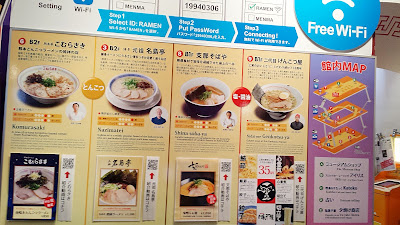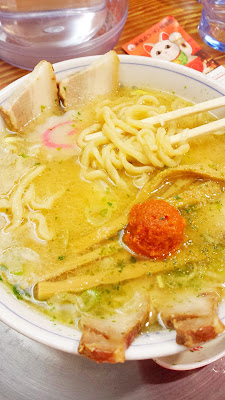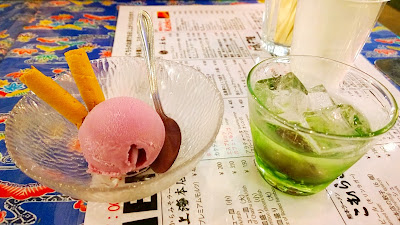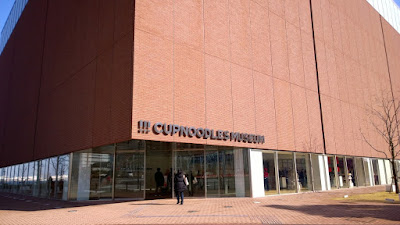Last week, I covered part one of our day trip to the Yokohama area, and visiting the Cup Noodles Ramen Museum and making our own custom Cup Noodles. Part two is when we headed to the Shin Yokohama Ramen Museum. Shin Yokohama is located about 15 minutes from Yokohama, or about 45 minutes from Tokyo.

We didn’t stay to eat ramen at the Cup Noodles Ramen Museum during our visit because it isn’t vegetarian friendly – and by vegetarian I include not eating seafood. There are lots of places in Japan to eat delicious ramen, and you can even find several areas where there are many ramen joints close together so you can progressively enjoy multiple ramen shops at once – the famous areas particularly are Tokyo Ramen Street at Tokyo Station, and Kyoto Ramen Koji/Street. But, good luck again finding multiple vegetarian ramen.
The Shin Yokohama Ramen Museum, on the other hand, not only offers multiple ramen, including “mini” portions that are smaller intentionally to help you try multiple bowls of ramen. And, there are multiple vegetarian ramen choices if you combine all the 9 shop options. And, the vegetarian ones are clearly marked. If you don’t eat pork, these are also clearly marked.
Atmosphere
After purchasing your entrance admission (310 yen) to the Ramen Museum here, you have a day pass – so you could come for lunch and then leave and get your hand stamped and return for dinner. After going through the turnstile showing your ticket or handstamp, you enter a entrance hallway. Here, you can see boards listing the free wifi information as well as info about the different ramen shops you can dine at and what they specialize in. They have brochures too with a map in multiple languages.

I should warn now that although it is titled the Shin Yokohama Ramen Museum, I would not really call this a museum. It really qualifies more as a food amusement park featuring ramen dishes from different regions of Japan. The museum is part of the gift shop and maybe has only 2 walls worth of information letting you know about the 26 prefectures and showing you some historical ramen items, but not much else in terms of content. The museum is the same size as the gift shop, which is smaller than the slot race track which I’m not quite sure why it’s also here.
To get to the food part, descend to the 2 floors of basement below – you can find small lockers on your way down here to leave your coats if you’d like. As you go down the stairs, the effect is as if you had just walked down the stairs from the train, and it’s also a jump back in time because the streetscape is like it’s almost dusk in 1958. Even though this area is really 2 floors of basement, the details of the sky, the 2nd floor windows with laundry and lights like they are apartments, and first floor windows are decorated like storefronts or movie theaters, really add to a cool atmosphere of old era Tokyo.
On the first floor of the basement, there are even sound effects on loundspeakers of monks chanting, or a cat meowing, or movies or radio music from the era, as you walk down the different “alleys” of a neighborhood of homes and bars that circle around the since the middle area is open to the second floor.
There are different food stands throughout the 2 floors including 8 ramen shops, 1 Okinawa Izakaya tavern, a bar, and a cafe and snack shop. There is also a fortune teller at a table you can visit, a old fashioned neighborhood sweets shop, and there seems to be a game for kids in Japanese where they help look for clues and solve a crime/Wanted Poster cases as we saw them turning their evidence into a “uniformed officer” during our visits. We also saw other performers, like a magician.
To order, like many ramen shops, there is a machine by the door where you put in money. After pushing buttons corresponding to your food, little slips of paper with the dish names print out. This is true of all the ramen shops, the Izakaya tavern, as well as the bar at Shin Yokohama Ramen Museum.
As a plus though, here at the Shin Yokohama Ramen Museum there are also several large laminated menus in multiple languages (Japanese, Chinese, Thai, and English) with corresponding numbers to match the machine buttons and with symbols standing for whether a dish has pork, is vegetarian, etc.
Not only are main dishes like ramen on the machine, but so are extra accompaniments you might want to eat such as extra meat, noodles, rice, or side dishes, or beverages. For instance at the shop Nidai-me Genkotsu-ya they offer jumbo gyoza – just look how big they are compared to my chopsticks!
They were super juicy too…
When there are seats available you hand it to the attendant at the front and they will bring you your food when it’s ready. On the menu, there are always a few “mini” smaller portions so you can try a couple different ramen from different places. Every person who sits down is expected to order ramen if they are an adult.
Ramen Recap
The first ramen place we decide to try at Shin Yokohama Ramen Museum is at the shop Ryu Shanghai Honten, whose trademark is in its super-fat noodles folded over 32 times and that their spicy miso ramen is topped off with a scoop of the raw, spicy-hot miso. They had a mini version of this specialty spicy miso ramen that I ordered, while F got a full portion of his first vegetarian ramen.

The second ramen place we decide to try is an Italian ramen restaurant called Casa Luca featuring Milano Tonkotsu that is advertised as having Italian flavor, plus you can order it with Peperoncino or with Parmesan, though I did neither. The pork bone broth (tonkotsu) has olive oil added to it, the chashu is grilled after being massaged with Italian rock salt that gives a hint of pancetta, and the noodles use a blend of Japanese flour and Italian flour of Durum Semorena, a flour often used for Italian pasta and bread. This time the vegetarian shoyu ramen version looked different enough to get a photo. You can also order Italian sodas and wine if you’d like at this shop.
Next for the third ramen he and I separated- him to Komurasaki known for their specially-flavored oil, and roasted, crumbled garlic chips on their ramen to get the vegetarian ramen there, while I headed to the famous Sumire which didn’t offer vegetarian ramen. Here’s a look at their shoyu broth ramen and then their famous miso ramen where the meat is minced and distributed throughout the bowl so some people order a bowl of rice to go with their miso ramen. Of all the noodles I had these were my favorite of all the shops, they are Hokkaido-style noodles that are medium-thick, slightly hard and curvy.
F’s vegetarian ramen from Muku Zweite and then my mini ramen with meat. The ingredients for the ramen noodles uses durum flour for pasta and flour for pizza which is unique for this ramen shop with origins from Frankfurt, Germany. For my ramen broth, the soup is boiled for 3 days with pork bone and chicken. You can also order German beer and currywurst sausage here in the shop and include as one of your toppings for the ramen sauerkraut (!? Which I didn’t do).
Finally, the Okinawa “Ryukyu new noodles Tondo” by tavern Ryo Next / Izakaya Ryouji with their scorched black shoyu ramen.
Dessert at the bar included shochu and sweet potato ice cream, and beer.


I know some online reviews complained about having to pay an admission to then pay for food and drink at shops to eat, but 310 yen is so little for the clean access to restrooms and the wi fi and the English translations I think it’s totally worth it – and even more so if you have a vegetarian with you, or someone who doesn’t eat pork, since both those are labeled on all the menus here. As a vegetarian, F loved that he has multiple options here and so I definitely recommend if you are vegetarian and in Tokyo you come and visit.
Perhaps I could have gotten better ramen at specific shops in Tokyo, but the ones here were pretty good and all conveniently located. I did try to go to Tokyo Street later during the trip, but the lines were so long we ended up coming back to Shin Yokohama Ramen Museum a second time to get ramen we missed during our first visit. I would be impressed if you can fit more than 3 mini ramen portions in a visit – because that’s all I could handle.
Check out the Shin Yokohama Museum website for which ramen shops are here (they may rotate) – they have the menus of each of the shops, and also an approximate waiting time if any, but only on the Japanese version of the website so you’ll need to translate. They also have videos with subtitles of visits to each shop to give you an idea of the various shop specialties before you visit available on both the Japanese and English versions of the site.
For me, my favorite style of Japanese Ramen is the intense Sapporo style ramen which has the depth of a fermented miso base, especially with the additional topping of corn and a pat of butter, and Hokkaido noodles which are thicker and wavy instead of straight, which makes a different in that they are more firm and I like the texture of the slight folds even though it means more likely splatter when slurping. The soup is so super rich that you can order an additional plate of noodles after your first bowl (kaedama) to add to your soup and still be really happy. At least that’s me.
What do you think of the Shin Yokohama Ramen Museum – would you call it a food amusement park? Would you ever visit a food amusement park – and what of food would you want to see featured?
Next time on my Japan Travel post, I’m finally going to take you out of the Tokyo area and show you our explorations in Kyoto! And if you are getting a craving for ramen after this post, come back on Friday when I talk about where you can get authentic Tokyo ramen in Portland.
Here’s a summary of my Japan Travel post series:
- Guide to Planning a Trip: Research
- Guide to Planning a Trip: Mapping
- Hagoita Ichi Winter Festival at Sensoji Temple, Japan
- Japanese Treats at Temples and Shrines
- Winter Illuminations in Tokyo (Winter Season – November – February!)
- Snow Monkeys in Hot Springs
- Onsen by Mount Fuji covers Onsen 101 and how we loved our stay at Lake Kawaguchiko
- Dining at a Ryokan a look at what a traditional dinner and breakfast might be during a ryokan stay
- Visiting Cup Noodles Museum in Yokohama (just outside Tokyo)
- Visiting Shin Yokohama Ramen Museum
- Kyoto Temples and Shrines (walking tour starting in Higashimaya with stops especially at Kiyomizudera Temple, Kodaji Temple, Heian Shrine)
- Kyoto Temples in Arashiyama
- Kyoto Tofu
- Kyoto Famous Sights of the Kinkakuji (The Golden Pavilion) and Fushimi Inari (Red Torii Gates)
- Famous Signs of Osaka and eating Osaka Food specialities like okonomiyaki, takoyaki and kushikatsu
- Visiting Himeji Castle, the famous white castle in Japan
- Fun at Japanese Cafes and More including Maid Cafe, Cat Cafe; theme parks of J World and Namja Town, a geeky stop at Kanda Myojin, and Ghibli Museum
- Japan Eating Checklist is my top 25 list of things to try to include as an eating experience when visiting Japan
- New Year’s in Japan: Oji Fox Parade, and some photos of a Meiji Shrine visit on New Year’s Day














